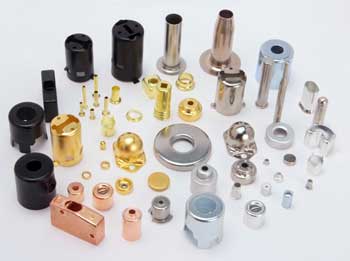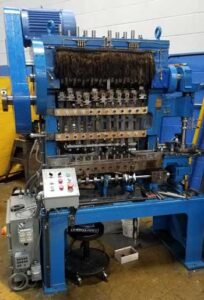Deep Drawing
 Deep drawing is a type of metal forming process where parts are produced by punching sheet metal into a formed die. It allows for superior quality components, produced at high speeds, and often at lower costs than competing methods. Deep drawn parts are found in countless applications for many industries including consumer, medical, military, communications and many others. They can be made from a variety of materials including brass, stainless steel, alloys and more.
Deep drawing is a type of metal forming process where parts are produced by punching sheet metal into a formed die. It allows for superior quality components, produced at high speeds, and often at lower costs than competing methods. Deep drawn parts are found in countless applications for many industries including consumer, medical, military, communications and many others. They can be made from a variety of materials including brass, stainless steel, alloys and more.
Drawing Process Overview
- First, a design is created, typically via CAD. Tooling is then made or configured to produce the specific part.
- The deep drawn part starts as flat material which is cut into circular blanks from a strip of metal.
- The blank is then pushed into the die using a punch, which produces a simple, cup-shaped component.
- Afterward, it moves down the line to be processed further to form additional features. Excess metal is also trimmed during this phase. It may move through multiple processing steps, depending on the complexity of the component.
- Depending on the part and its application, secondary operations may then be applied such as anodizing, fixturing, heat treating, passivation, plating, painting, welding, etc.
Benefits of Deep Drawing
There are many benefits to using deep drawing over competing methods for parts that qualify, here are just a few:
- Drawn parts are seamless, giving them impressive strength and durability
- Lower unit production cost, particularly with higher runs
- Reduced tooling costs
- While it’s ideal for cylindrical components, it also allows for more complex part geometries
- Decreased material waste, which helps keeps costs lower than other processes
A Brief History of Deep Drawing
 This story of deep drawing metal components stretches back to the mid 1800’s, in Waterbury CT, where The Platt Brothers and Company is headquartered. Platt was establisher earlier that century, as an importer of brass and manufacturer of brass buttons. Waterbury was known in those days, and for decades beyond, as the “Brass City of the World”. The surrounding Naugatuck Valley is still referred to as “The Brass Valley”.
This story of deep drawing metal components stretches back to the mid 1800’s, in Waterbury CT, where The Platt Brothers and Company is headquartered. Platt was establisher earlier that century, as an importer of brass and manufacturer of brass buttons. Waterbury was known in those days, and for decades beyond, as the “Brass City of the World”. The surrounding Naugatuck Valley is still referred to as “The Brass Valley”.
Eli Manville, a master mechanic, is credited as the founder of the deep drawing process. His company, Eli Manville company, developed the first so-called “eyelet machine”. It’s better known today as a transfer press, as shown here. It was originally built to manufacture eyelets, which were used for clothing, shoes, and many other applications at the time. Steel dies were later added to the process, allowing for a huge range of parts that are manufactured today using the same process.
Typical Parts Made by the Deep Draw Process
- Aerosol mounting caps
- Battery cases
- Blasting caps
- Buttons
- Canisters
- Cans
- Connectors
- Cups
- Electrode tips
- Eyelets
- Fasteners
- Ferrules
- Grommets
- Housings
- Light bulb screw shells
- Lipstick cases
- Munitions
- Rivets
- Shells
- Sleeves
- Tubes
Industries Served
Deep drawing serves many industries today, including:
- Aerospace
- Automotive
- Communications
- Construction
- Control Valves
- Electronics
- Lighting
- Medical
- Military
- Sensors / IoT
Materials Used
- Stainless Steel
- Aluminum
- Brass
- Copper Based Alloys
- Titanium
- Precious Metals
- Clad and Pre-Plated Materials
- Cold Rolled Steel


